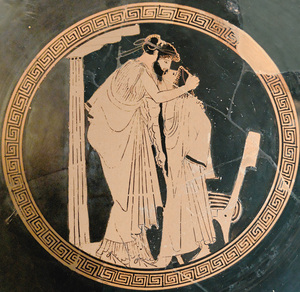Still working to recover. Please don't edit quite yet.
ephebophilia
Ephebophilia is a sexual attraction to post-pubescent adolescents. It should be distinguished from attraction to pre-pubescent children (described as pedophilia). Ephebophilia sometimes erroneously is meant to include hebephilia.
Sexual desire that includes adolescents as well as older individuals is common among adults with many sexual orientations;[unverified] this is not labeled "ephebophilia" because the attraction to adolescents is not exclusive. In some cultures, such as those in which adolescent girls are routinely married to older men, it is considered normal for adults to include adolescents among their sexual interests. In these cultures an attraction to adolescents is not necessarily thought to require an essentialist classification in terms of abnormality, deviancy or mental health, but is seen as a possibility or a taste. In certain Middle-Eastern cultures, as reflected in literature written in Turkish, Persian and Urdu, the expression of love for attractive adolescent boys is found in classical literature.[unverified] In Urdu, for instance, it may be a metaphor for the mystic's quest for an immanent deity; a lover's desire for a woman who, being a veiled lady or a courtesan, is impossible to own; or in some cases, boys who take the place of women in gender-segregated societies (Rahman 1989). This attraction of men to adolescent males is not seen as effeminate or regarded as homosexuality, per se, but is usually considered sinful (Rahman 1988). Nonetheless, an open attraction to adolescents may still be ridiculed or disparaged as inappropriate or unhealthy; an attraction to adolescents is something one is expected to "grow out of". These cultural assumptions have come into contention with the advent of modernity and the resultant exposure to cultures with different views.
Etymology[edit]
It comes from the Template:lang-el (ephebos) variously defined as "one arrived at puberty", "a youth of 18 who underwent his dokimasia and was registered as a citizen (Athens)", and "arriving at man's estate"; and φιλία (-philia) "love".[1] Despite this classical etymology it is a term of modern coinage, having been attributed to German scientist Magnus Hirschfeld several times, often giving a date between 1906-08. [unverified] It has been used by Dutch psychologist and pedophile activist Frits Bernard as far back as 1950[2], reprinted in 1960 in the gay support magazine Vriendschap under the pseudonym Victor Servatius[3], also crediting it to Hirschfeld though giving no exact date.[4] It has also been used by the Frenchman Felix Buffiere in 1980 and described at length by Tariq Rahman in 1988 who argues that it should be used in preference to 'homosexuality' for describing grown men's aesthetic and erotic interest in adolescent boys when classical literatures in Persian, Turkish or Urdu are under discussion.
In culture[edit]
In fairytales, adolescent girls are sometimes made the object of limerence from older men. While suggesting it, this is not ephebophilia since the males do not have exclusive sexual preference for young girls. Some fairytales that are alleged to contain ephebophilia are Rimsky-Korsakov's opera version of the Snow Maiden, Vasilissa the Beautiful, and Sadko.[unverified] These themes are sometimes correlated with gerontophobia.
Legality[edit]
While ephebophilic desire is not regulated by any statute, aspects of sexually expressed ephebophilia may be against some laws. Depending on the age of consent in a given jurisdiction, an adolescent may be capable of giving legally-recognised consent to sexual activity. If the younger partner is below that age, it is commonly criminalised as statutory rape, regardless of whether the younger partner agrees to - or even initiates - the activity. Reasons given for this include:
- Some adolescents are unable to understand the physical, emotional, and social consequences of sexual activity. According to the August 2006 issue of Scientific American, the neurological development of late adolescents is not yet complete, leading to deficits in their higher cognitive functions including judgement, attention, and response to crisis situations. However, late adolescence also includes people over 18, since neurological development is still not complete at this age.
- Adult sexual relations with adolescents can be an abuse of power, using psychological coercion.
- Sexual relations with adolescents can lead to pregnancy and parenthood, for which adolescents may not be prepared emotionally and/or financially.
Relationships between adults and adolescents that do not include sexual activity are generally legal, assuming no other laws regarding child welfare are violated. For example, a romantic relationship with an adolescent below the age of consent is generally legal, especially when the adolescent's age is above the age at which their parents could consent to marriage. In other jurisdictions, this may be illegal.
| List of sexualities by age of attraction |
|---|
| infantophilia | pædophilia | hebephilia | ephebophilia | teleiophilia | gerontophilia |
| Related topics: age of attraction | age disparity in sexual relationships | chronophilia |
| This article contains content from Wikipedia. Current versions of the GNU FDL article Ephebophilia on WP may contain information useful to the improvement of this article | WP |
- ↑ Rahman, Tariq (1988). "Ephebophilia: the case for the use of a new word," Forum for Modern Language Studies, 24(2), 126-141.
- ↑ http://www.nvva.nl/rijzendezon/catalogs/c00137.htm
- ↑ Selected publications of Dr. Frits Bernard - An international bibliography
- ↑ Dr. Victor Servatius (1960). Ephebophilie en wetenschap ("Ephebophilia and science"), Vriendschap, vol. 15, March 1960, pp. 35-35
